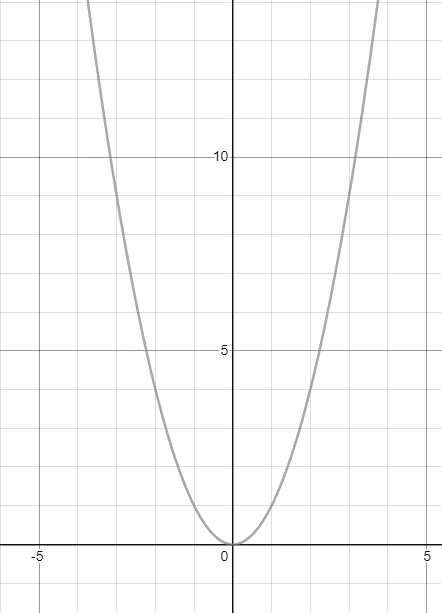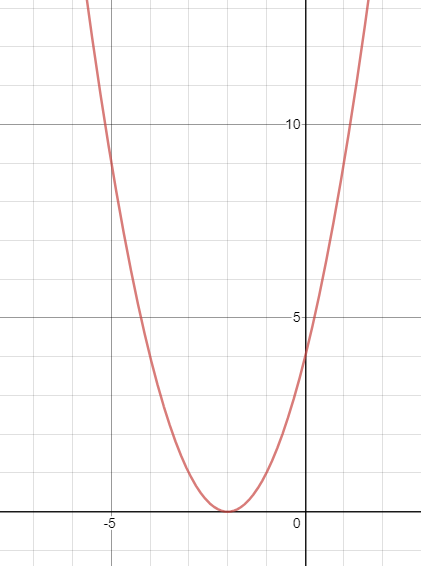Answer
384.6k+ views
Hint: In this question we need to find the graph of \[y = {\left( {x + 2} \right)^2}\] and determine the transformation for it. To obtain the graph find the value of y for the different value of x and then mark the points on the graph to make the graph. Also to determine the transformation, determine the change in the transformation from parent function to given function.
Complete Step By Step solution:
In this question we have given a function that is \[y = {\left( {x + 2} \right)^2}\] and we need to sketch the graph and need to describe the transformation.
The above function is the quadratic function. The parent function for the quadratic function is \[y = {x^2}\].
Consider the table of values for this parent function is,
From the above table the graph for the parent function is shown below.

Now we will consider the table of values for this given function is,
From the above table the graph for the given function is shown in figure below.

From the graph for the parent function and the graph for the given equation. It is concluded that the graph of \[{\left( {x + 2} \right)^2}\] is shifted \[2\] unit to the left from the parent function \[{x^2}\].
Note:
As we know that the quadratic equation is the equation that is of the standard from \[a{x^2} + bx + c\]. Here, a and b are the coefficients and c is the constant. In the general equation the highest power of the x is \[2\] so the equation is called quadratic. The range of all the quadratic functions lies from \[ - \infty \] to \[\infty \].
Complete Step By Step solution:
In this question we have given a function that is \[y = {\left( {x + 2} \right)^2}\] and we need to sketch the graph and need to describe the transformation.
The above function is the quadratic function. The parent function for the quadratic function is \[y = {x^2}\].
Consider the table of values for this parent function is,
| \[y\] | \[x\] |
| \[4\] | \[ - 2\] |
| \[9\] | \[ - 3\] |
| \[25\] | \[ - 5\] |
| \[49\] | \[ - 7\] |
| \[64\] | \[ - 8\] |
| \[4\] | \[2\] |
| \[9\] | \[3\] |
| \[25\] | \[5\] |
| \[49\] | \[7\] |
| \[64\] | \[8\] |
From the above table the graph for the parent function is shown below.

Now we will consider the table of values for this given function is,
| \[y = {\left( {x + 2} \right)^2}\] | \[x\] |
| \[0\] | \[ - 2\] |
| \[1\] | \[ - 3\] |
| \[9\] | \[ - 5\] |
| \[25\] | \[ - 7\] |
| \[36\] | \[ - 8\] |
| \[16\] | \[2\] |
| \[25\] | \[3\] |
| \[49\] | \[5\] |
| \[81\] | \[7\] |
| \[100\] | \[8\] |
From the above table the graph for the given function is shown in figure below.

From the graph for the parent function and the graph for the given equation. It is concluded that the graph of \[{\left( {x + 2} \right)^2}\] is shifted \[2\] unit to the left from the parent function \[{x^2}\].
Note:
As we know that the quadratic equation is the equation that is of the standard from \[a{x^2} + bx + c\]. Here, a and b are the coefficients and c is the constant. In the general equation the highest power of the x is \[2\] so the equation is called quadratic. The range of all the quadratic functions lies from \[ - \infty \] to \[\infty \].
Recently Updated Pages
How many sigma and pi bonds are present in HCequiv class 11 chemistry CBSE

Why Are Noble Gases NonReactive class 11 chemistry CBSE

Let X and Y be the sets of all positive divisors of class 11 maths CBSE

Let x and y be 2 real numbers which satisfy the equations class 11 maths CBSE

Let x 4log 2sqrt 9k 1 + 7 and y dfrac132log 2sqrt5 class 11 maths CBSE

Let x22ax+b20 and x22bx+a20 be two equations Then the class 11 maths CBSE

Trending doubts
Fill the blanks with the suitable prepositions 1 The class 9 english CBSE

At which age domestication of animals started A Neolithic class 11 social science CBSE

Which are the Top 10 Largest Countries of the World?

Give 10 examples for herbs , shrubs , climbers , creepers

Difference between Prokaryotic cell and Eukaryotic class 11 biology CBSE

Difference Between Plant Cell and Animal Cell

Write a letter to the principal requesting him to grant class 10 english CBSE

Change the following sentences into negative and interrogative class 10 english CBSE

Fill in the blanks A 1 lakh ten thousand B 1 million class 9 maths CBSE



